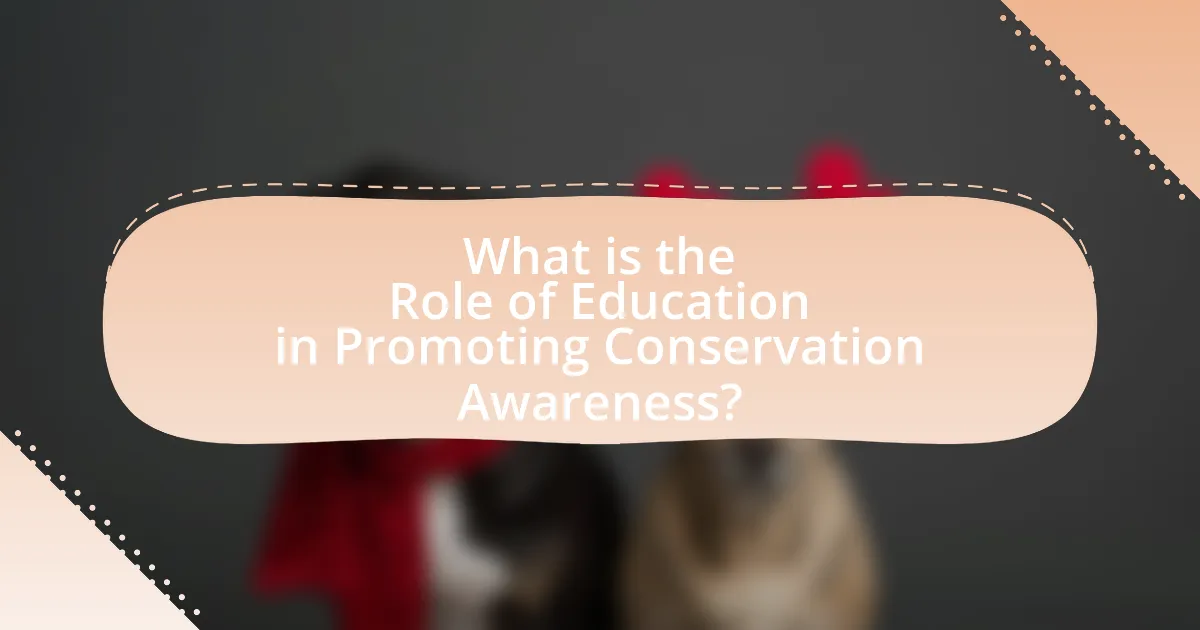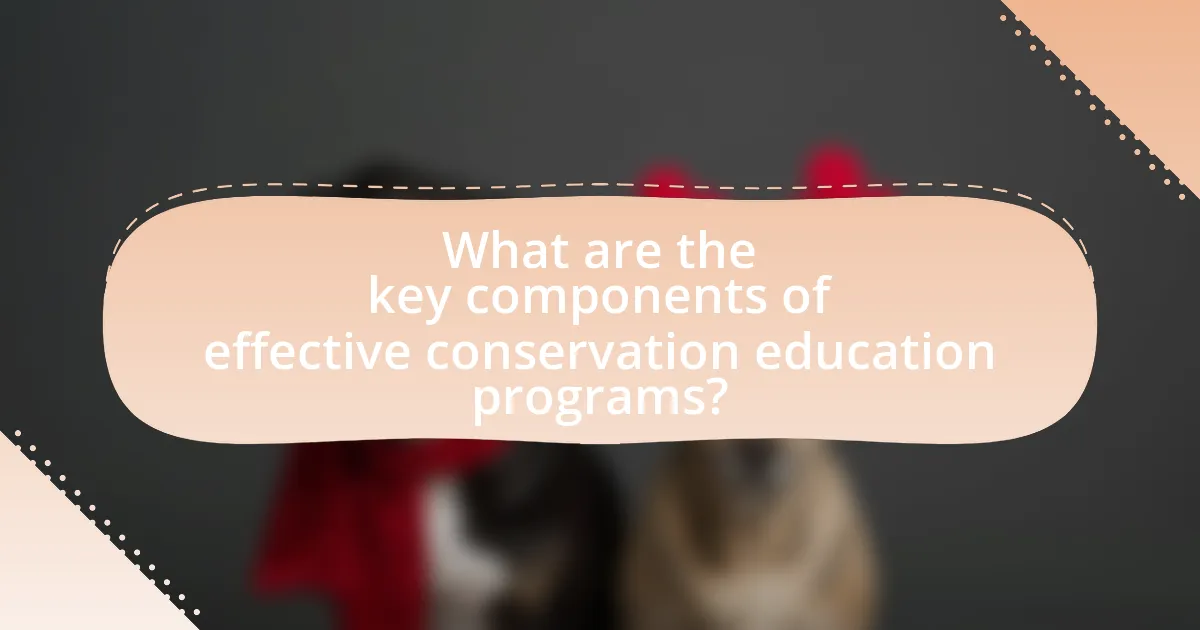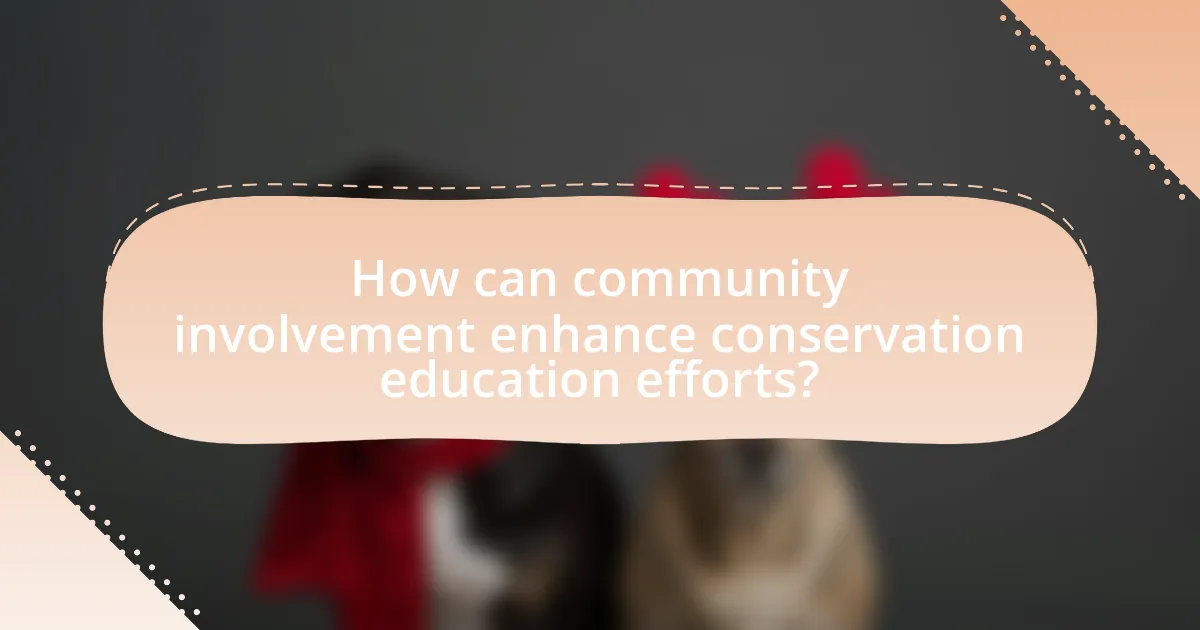The main entity of the article is the role of education in promoting conservation awareness. The article outlines how education equips individuals with knowledge about environmental issues and sustainable practices, leading to increased pro-environmental behaviors. It discusses effective educational methods, the varying responses of different age groups to conservation education, and the importance of community involvement. Additionally, it highlights the environmental impacts of a lack of conservation awareness and the contributions of conservation education to sustainable development. Key components of effective conservation education programs, curriculum design, and the role of technology and community organizations in enhancing conservation awareness are also examined.

What is the Role of Education in Promoting Conservation Awareness?
Education plays a crucial role in promoting conservation awareness by equipping individuals with knowledge about environmental issues and sustainable practices. Through structured curricula and community programs, education fosters an understanding of biodiversity, ecosystems, and the impact of human activities on the environment. For instance, studies have shown that environmental education can lead to increased pro-environmental behaviors, as evidenced by a 2018 report from the North American Association for Environmental Education, which found that students who participated in environmental education programs demonstrated a 50% increase in conservation-related actions. This highlights the effectiveness of education in shaping attitudes and behaviors towards conservation, ultimately leading to a more informed and responsible society.
How does education influence conservation awareness among individuals?
Education significantly enhances conservation awareness among individuals by providing knowledge about environmental issues and fostering a sense of responsibility towards nature. Research indicates that educational programs focused on ecology and sustainability lead to increased understanding of biodiversity and the impacts of human activities on ecosystems. For instance, a study published in the Journal of Environmental Education found that students who participated in hands-on conservation projects demonstrated a 30% increase in their awareness of local environmental issues compared to those who did not engage in such activities. This evidence underscores the critical role that education plays in shaping attitudes and behaviors related to conservation.
What educational methods are most effective in raising conservation awareness?
Interactive and experiential learning methods are most effective in raising conservation awareness. These methods engage participants directly, fostering a deeper understanding of environmental issues. For instance, hands-on activities such as field trips, community-based projects, and citizen science initiatives have been shown to significantly enhance knowledge retention and behavioral change regarding conservation. Research by the National Environmental Education Foundation indicates that experiential learning can increase environmental stewardship by up to 70% compared to traditional lecture-based approaches. Additionally, integrating technology, such as virtual reality experiences that simulate ecological impacts, has proven effective in capturing attention and conveying complex conservation concepts.
How do different age groups respond to conservation education?
Different age groups respond to conservation education in varied ways, influenced by cognitive development and life experiences. Children, typically aged 5-12, often engage through interactive and hands-on activities, which foster curiosity and a sense of responsibility towards the environment. Adolescents, aged 13-18, tend to respond better to discussions that connect conservation to social issues, as they are developing critical thinking skills and are more socially aware. Adults, particularly those aged 25-50, often require data-driven approaches that highlight the economic and health benefits of conservation, as they are more likely to make decisions based on practical implications. Older adults, aged 50 and above, may respond positively to conservation education that emphasizes legacy and stewardship, appealing to their desire to leave a positive impact for future generations. Research indicates that tailored educational strategies enhance engagement and retention across these age groups, demonstrating the importance of age-appropriate methods in conservation education.
Why is conservation awareness important in today’s society?
Conservation awareness is crucial in today’s society because it fosters understanding and action towards protecting natural resources and biodiversity. Increased awareness leads to informed decision-making, encouraging individuals and communities to adopt sustainable practices that mitigate environmental degradation. For instance, studies show that education initiatives on conservation can significantly enhance public engagement, as evidenced by a report from the United Nations Environment Programme, which highlights that communities involved in conservation education programs are more likely to participate in sustainable resource management. This correlation underscores the importance of integrating conservation awareness into educational frameworks to ensure a sustainable future.
What are the environmental impacts of a lack of conservation awareness?
A lack of conservation awareness leads to significant environmental degradation, including habitat loss, biodiversity decline, and increased pollution. When individuals and communities are unaware of the importance of conservation, they are more likely to engage in practices that harm ecosystems, such as deforestation, overfishing, and improper waste disposal. For instance, the World Wildlife Fund reports that habitat destruction is a primary driver of species extinction, with approximately 1 million species at risk due to human activities. Furthermore, without awareness, communities may neglect sustainable practices, resulting in increased carbon emissions and climate change impacts. This lack of education directly correlates with the deterioration of natural resources, threatening both ecological balance and human livelihoods.
How does conservation awareness contribute to sustainable development?
Conservation awareness significantly contributes to sustainable development by fostering responsible resource management and promoting environmental stewardship. When individuals and communities understand the importance of conserving natural resources, they are more likely to adopt practices that reduce waste, protect ecosystems, and support biodiversity. For instance, studies show that education initiatives focused on conservation can lead to a 30% increase in community participation in sustainable practices, such as recycling and habitat restoration. This heightened awareness not only helps preserve the environment but also supports economic growth by ensuring that resources remain available for future generations.

What are the key components of effective conservation education programs?
Effective conservation education programs consist of several key components: clear objectives, engaging content, hands-on experiences, community involvement, and evaluation mechanisms. Clear objectives ensure that the program has specific goals, such as increasing awareness about local ecosystems or promoting sustainable practices. Engaging content, which includes interactive materials and relatable narratives, captures the attention of participants and fosters a deeper understanding of conservation issues. Hands-on experiences, such as field trips or citizen science projects, allow participants to apply their knowledge in real-world settings, enhancing retention and motivation. Community involvement encourages collaboration and support, making conservation efforts more relevant and impactful. Finally, evaluation mechanisms assess the program’s effectiveness, providing feedback for continuous improvement. Research indicates that programs incorporating these components are more successful in achieving their conservation goals, as evidenced by studies showing increased participant engagement and behavior change in conservation practices.
How can curriculum design enhance conservation education?
Curriculum design can enhance conservation education by integrating interdisciplinary approaches that connect ecological concepts with real-world applications. This integration fosters critical thinking and problem-solving skills among students, enabling them to understand the complexities of environmental issues. For instance, a study by the National Science Teachers Association highlights that curricula incorporating hands-on activities and local environmental studies significantly improve students’ engagement and retention of conservation principles. By aligning educational content with local ecosystems and conservation challenges, curriculum design not only raises awareness but also empowers students to take actionable steps towards sustainability.
What subjects should be included in conservation education curricula?
Conservation education curricula should include subjects such as ecology, environmental science, biodiversity, sustainable development, and climate change. These subjects provide foundational knowledge about ecosystems, species interactions, and the impact of human activities on the environment. For instance, ecology teaches the relationships between organisms and their environments, while environmental science covers the principles of sustainability and resource management. Additionally, incorporating biodiversity education emphasizes the importance of species conservation and the role of ecosystems in maintaining ecological balance. Climate change education is crucial for understanding the challenges posed by global warming and the need for mitigation strategies. Together, these subjects equip learners with the necessary skills and knowledge to engage in conservation efforts effectively.
How can hands-on experiences improve learning outcomes in conservation education?
Hands-on experiences significantly enhance learning outcomes in conservation education by facilitating active engagement and practical application of knowledge. When learners participate in activities such as fieldwork, habitat restoration, or wildlife monitoring, they develop a deeper understanding of ecological concepts and the importance of conservation efforts. Research indicates that experiential learning can increase retention rates by up to 75%, compared to traditional lecture-based methods, which typically yield retention rates of around 5-10%. This active involvement fosters critical thinking, problem-solving skills, and a personal connection to environmental issues, ultimately leading to more informed and motivated conservation advocates.
What role do educators play in promoting conservation awareness?
Educators play a crucial role in promoting conservation awareness by integrating environmental education into their curricula. They facilitate understanding of ecological principles, biodiversity, and the impact of human activities on the environment. Research indicates that students exposed to environmental education are more likely to engage in pro-environmental behaviors; for instance, a study published in the Journal of Environmental Education found that students who participated in conservation-focused programs demonstrated increased knowledge and positive attitudes towards environmental stewardship. By fostering critical thinking and encouraging active participation in conservation initiatives, educators empower students to become informed advocates for sustainability.
How can teachers be trained to effectively teach conservation topics?
Teachers can be trained to effectively teach conservation topics through specialized professional development programs that focus on environmental education methodologies. These programs should incorporate hands-on training, curriculum development, and the integration of local conservation issues to enhance relevance and engagement. Research indicates that teachers who participate in workshops that emphasize experiential learning and community involvement are more effective in conveying conservation concepts (National Research Council, 2012). Additionally, ongoing support and resources, such as access to updated materials and collaboration with conservation organizations, further empower teachers to deliver impactful lessons on conservation.
What resources are available for educators to enhance conservation education?
Educators can enhance conservation education through various resources, including curriculum guides, online platforms, and community partnerships. For instance, organizations like the National Wildlife Federation provide comprehensive curriculum materials that align with educational standards, facilitating the integration of conservation topics into classroom learning. Additionally, platforms such as Project Learning Tree offer interactive activities and lesson plans focused on environmental education. Community partnerships with local conservation groups can also provide hands-on experiences and real-world applications of conservation principles, further enriching the educational experience. These resources collectively support educators in fostering a deeper understanding of conservation issues among students.

How can community involvement enhance conservation education efforts?
Community involvement enhances conservation education efforts by fostering local engagement and ownership of environmental issues. When communities actively participate in conservation initiatives, they develop a deeper understanding of ecological challenges and solutions. Research indicates that programs involving community members in hands-on activities, such as habitat restoration or wildlife monitoring, significantly increase awareness and knowledge about local ecosystems. For instance, a study published in the Journal of Environmental Education found that participants in community-led conservation projects demonstrated a 40% increase in environmental knowledge compared to those who did not engage in such activities. This active participation not only educates individuals but also cultivates a collective responsibility towards conservation, leading to more sustainable practices and policies at the local level.
What are the benefits of community-based conservation education initiatives?
Community-based conservation education initiatives enhance environmental awareness and promote sustainable practices within local populations. These initiatives empower communities by providing knowledge about local ecosystems, fostering a sense of stewardship, and encouraging active participation in conservation efforts. Research indicates that when communities are educated about the ecological and economic benefits of biodiversity, they are more likely to engage in conservation activities. For instance, a study published in the journal “Conservation Biology” found that community-led programs significantly increased local engagement in conservation, leading to improved biodiversity outcomes. Additionally, these initiatives often result in stronger community ties and increased resilience against environmental changes, as individuals work collaboratively towards common conservation goals.
How can local organizations collaborate with schools to promote conservation awareness?
Local organizations can collaborate with schools to promote conservation awareness by developing educational programs and resources that align with school curricula. These organizations can provide workshops, guest speakers, and hands-on activities that engage students in conservation topics, such as biodiversity and sustainability. For instance, a study by the National Wildlife Federation found that schools partnering with local conservation groups saw a 30% increase in student participation in environmental projects. This collaboration not only enhances students’ understanding of conservation but also fosters a sense of responsibility towards the environment.
What role do volunteers play in conservation education programs?
Volunteers play a crucial role in conservation education programs by facilitating hands-on learning experiences and engaging communities in conservation efforts. They often assist in organizing educational workshops, leading field trips, and providing support for outreach initiatives, which enhances public awareness about environmental issues. Research indicates that programs involving volunteers can increase participant engagement and retention of information, as seen in studies conducted by the National Park Service, which found that volunteer-led programs significantly improved visitor understanding of conservation practices.
How can technology be leveraged to promote conservation awareness?
Technology can be leveraged to promote conservation awareness through digital platforms, interactive applications, and social media campaigns. These tools facilitate the dissemination of information about environmental issues, enabling users to engage with content that raises awareness about conservation efforts. For instance, virtual reality experiences allow users to explore endangered ecosystems, fostering empathy and understanding of the need for conservation. Additionally, data visualization tools can present complex environmental data in an accessible manner, making the impact of human activities on biodiversity more comprehensible. Research indicates that social media campaigns can significantly increase public engagement; for example, the #TrashTag challenge successfully motivated thousands to clean up littered areas, demonstrating the power of technology in mobilizing community action for conservation.
What digital tools are effective in delivering conservation education?
Digital tools effective in delivering conservation education include interactive websites, mobile applications, social media platforms, and virtual reality experiences. Interactive websites, such as National Geographic’s education portal, provide engaging content and resources that enhance learning about conservation topics. Mobile applications like iNaturalist allow users to document biodiversity and contribute to citizen science, fostering a deeper understanding of local ecosystems. Social media platforms, including Instagram and Twitter, facilitate the sharing of conservation stories and initiatives, reaching a broad audience and encouraging community involvement. Virtual reality experiences, such as those offered by Google Expeditions, immerse users in natural environments, promoting empathy and awareness of conservation issues. These tools leverage technology to create impactful educational experiences that resonate with diverse audiences.
How can social media campaigns raise awareness about conservation issues?
Social media campaigns can raise awareness about conservation issues by leveraging their vast reach and engagement capabilities to disseminate information quickly and effectively. These campaigns utilize visually compelling content, such as images and videos, to capture attention and convey the urgency of conservation efforts. For instance, the World Wildlife Fund’s #LastSelfie campaign highlighted endangered species, resulting in increased public discourse and donations, demonstrating the tangible impact of social media on conservation awareness. Additionally, platforms like Instagram and Twitter facilitate community building and mobilization, allowing individuals to share personal stories and experiences related to conservation, further amplifying the message.
What practical steps can individuals take to promote conservation awareness through education?
Individuals can promote conservation awareness through education by organizing community workshops focused on environmental topics. These workshops can cover subjects such as local biodiversity, sustainable practices, and the impact of climate change. Research indicates that hands-on learning experiences significantly enhance knowledge retention; for instance, a study by the National Oceanic and Atmospheric Administration found that participants in interactive educational programs showed a 70% increase in environmental knowledge. Additionally, individuals can create and distribute educational materials, such as brochures or online content, that highlight conservation issues and solutions, thereby reaching a broader audience. Engaging with local schools to incorporate conservation topics into the curriculum can also foster awareness among younger generations, as studies show that early education on environmental issues leads to more sustainable behaviors in adulthood.
How can individuals engage in local conservation education efforts?
Individuals can engage in local conservation education efforts by participating in community workshops and volunteering with local environmental organizations. These activities provide hands-on experience and knowledge about local ecosystems and conservation practices. For instance, organizations like the National Audubon Society offer programs that educate participants on bird conservation and habitat restoration, which can enhance community awareness and involvement in local conservation issues. Additionally, individuals can organize or attend informational sessions at schools or community centers to share knowledge about local wildlife and sustainable practices, fostering a culture of conservation within their communities.
What are some best practices for advocating conservation education in communities?
Best practices for advocating conservation education in communities include engaging local stakeholders, utilizing hands-on learning experiences, and integrating conservation topics into existing curricula. Engaging local stakeholders, such as community leaders and organizations, fosters collaboration and ensures that educational initiatives are relevant and culturally appropriate. Hands-on learning experiences, such as community clean-up events or wildlife monitoring programs, enhance understanding and encourage active participation. Integrating conservation topics into existing curricula, as demonstrated by programs like Project WILD, which aligns with educational standards, ensures that conservation education is sustained and reaches a broader audience. These practices collectively enhance community awareness and involvement in conservation efforts.